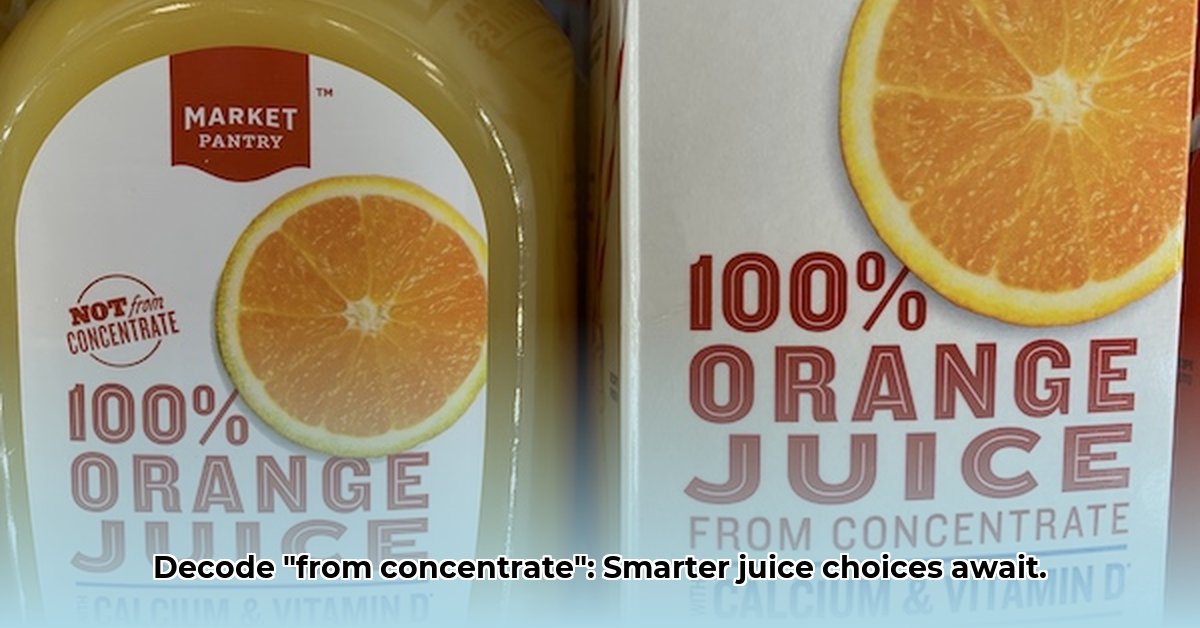Ever wondered what “Not From Concentrate” (NFC) means on a juice carton? It sounds premium, right? But is it really that different from regular juice? Let’s demystify the juice aisle. This article breaks down the NFC vs. “from concentrate” (FC) debate in simple terms, comparing production methods, nutritional value, taste, and cost. We’ll equip you with the knowledge to confidently navigate juice labels and choose the best option for your taste buds and health goals.
Unlocking the Mystery: “Not From Concentrate” Juice Explained
Standing in the juice aisle, the array of labels can be overwhelming. “Not From Concentrate” (NFC) and “From Concentrate” (FC) – what do these terms really signify? Let’s clarify the differences, empowering you to select the ideal juice based on your needs and preferences.
The Core Difference: Processing Methods and Their Impact
The fundamental distinction between NFC and FC juices lies in their manufacturing processes, which affect the final product’s taste, nutritional content, and cost. NFC juice undergoes minimal processing, akin to freshly squeezed juice made at home. FC juice, conversely, involves an extra step that influences its characteristics.
Side-by-Side Comparison: A Detailed Look at Juice Production
Let’s examine the step-by-step processes for both NFC and FC juices, considering factors like shelf life, cost, and the potential impact of additives:
Not From Concentrate (NFC):
- Fruit Selection & Washing: High-quality, ripe fruits are carefully selected and thoroughly washed to remove any impurities.
- Juice Extraction: Fruits are pressed or squeezed to extract the juice, preserving their natural flavors and aromas.
- Pasteurization (Optional): Some NFC juices undergo pasteurization, a quick heat treatment to eliminate harmful bacteria and extend shelf life. While pasteurization is common, some brands offer unpasteurized NFC juice.
- Immediate Packaging: The juice is promptly bottled and sealed to maintain freshness and prevent oxidation.
From Concentrate (FC):
- Fruit Preparation: Similar to NFC, the process begins with selecting and cleaning ripe fruits.
- Juice Extraction: The juice is extracted from the fruit, mirroring the initial step in NFC production.
- Water Removal (Concentration): This is the crucial step that differentiates FC juice. A significant portion of the water content is removed from the juice through evaporation or other methods, resulting in a concentrated form.
- Concentrate Storage: The concentrated juice is stored, often for extended periods, reducing storage and transportation costs.
- Reconstitution: When ready for packaging, the concentrate is mixed with water to restore the original juice consistency.
- Pasteurization: The reconstituted juice undergoes pasteurization to ensure safety and stability.
- Packaging: Finally, the juice is packaged and distributed for consumption.
Why the extra steps for FC juice? Concentrating the juice significantly reduces its volume and weight, making it more efficient and cost-effective to store and transport. This cost savings is often passed on to consumers, making FC juice generally more affordable.
Nutritional Value: Vitamins, Minerals, and Additives
Does NFC juice offer a significant nutritional advantage over FC juice? Not necessarily. Both 100% NFC and 100% FC juices can provide comparable amounts of vitamins and minerals, assuming no added sugars, artificial flavors, or preservatives are present.
The concentration process itself may lead to a slight reduction in certain heat-sensitive nutrients like vitamin C. However, the presence of added sugars and artificial ingredients has a far greater impact on the overall nutritional profile. Scrutinize the ingredient list for these additives, as they outweigh the subtle differences between NFC and FC processing.
Taste and Freshness: Does It Really Matter?
Many juice enthusiasts claim that NFC juice boasts a fresher, more vibrant flavor than its FC counterpart. This perception often stems from the minimal processing involved, which may help preserve the fruit’s natural aroma compounds. The shorter time between extraction and consumption can also contribute to a perceived increase in freshness. Ultimately, taste is subjective, and individual preferences vary. Conducting your own taste test can help you determine whether the perceived flavor difference justifies the potential cost difference.
Decoding Juice Labels: A Consumer’s Guide
Juice labeling regulations vary by country, but some key elements remain consistent. Always check the label for “100% juice” to ensure you’re getting pure juice without unnecessary fillers. Pay close attention to the ingredient list, specifically looking for added sugars (such as high fructose corn syrup, sucrose, or dextrose), artificial flavors, and preservatives.
Beware of misleading marketing terms. Claims like “fresh-squeezed” or “all-natural” do not automatically guarantee that a juice is NFC. These terms can be loosely regulated, so always verify the production process by examining the ingredient list and nutritional information.
Making Informed Choices: A Step-by-Step Guide
Here’s a practical guide to confidently navigate the juice aisle and select the best option based on your individual needs and priorities:
- Read the Label Carefully: Always scrutinize the ingredient list for hidden sugars, artificial additives, and preservatives. The nutrition facts panel provides valuable information for comparing different juice products.
- Prioritize 100% Juice: Opt for juices with minimal added ingredients, focusing on pure fruit juice without added sugars or artificial sweeteners.
- Consider Your Budget: NFC juices are often more expensive than FC juices due to higher production and transportation costs. Factor your budget into your decision-making process.
- Think About Storage: NFC juices typically have a shorter shelf life than FC juices and require refrigeration. Consider your consumption habits and storage capacity when making your selection.
- Don’t Judge a Juice Solely by its NFC Status: The most crucial factor is minimizing added sugars and artificial ingredients.
- Explore Different Brands: Sample different brands and varieties of both NFC and FC juices to discover your personal preferences.
The Evolving Juice Industry: Challenges and Opportunities
The juice industry is constantly adapting to meet changing consumer demands. Producing and marketing NFC juice presents unique challenges, including higher transportation costs, shorter shelf life, and the need for specialized storage facilities. However, the growing demand for minimally processed foods and the perceived superior quality of NFC juice have created significant opportunities for innovative producers.
The industry is actively exploring sustainable and cost-effective methods for producing and distributing NFC juices, including advancements in packaging technology, cold-chain logistics, and fruit sourcing.
Beyond the Bottle: Creative Uses for Juice
Juice isn’t just for drinking! “Not from concentrate” juice can be a versatile ingredient in the kitchen. Here are a few ideas:
- Smoothies: Add NFC juice to your favorite smoothie recipes for a boost of flavor and nutrients.
- Marinades: Use citrus-based NFC juices to tenderize meats and add a zesty flavor.
- Cocktails: Elevate your cocktails with fresh, flavorful NFC juice.
- Salad Dressings: Create a light and refreshing vinaigrette with NFC juice, olive oil, and herbs.
- Desserts: Incorporate NFC juice into sorbets, jellies, and other desserts for a naturally sweet treat.
Ultimately, choosing a juice involves more than just understanding the difference between NFC and FC. It’s about becoming a savvy consumer by carefully reading labels, considering your individual needs and preferences, and making informed decisions based on the overall ingredients. Remember, the healthiest choice is often the one that is closest to its natural state, with minimal added sugars and artificial additives.
- Discover Queen Zenobia of Palmyra: The Warrior Queen Who Defied Rome: Her Rise and Fall - July 31, 2025
- Discover Fermentation Revolution: The Health Benefits of Kimchi: Sustainable Farming Practices - July 30, 2025
- Discover Living Crystals: The Giant Gypsum Formations in Naica’s Cave: A Geological Marvel - July 30, 2025
















